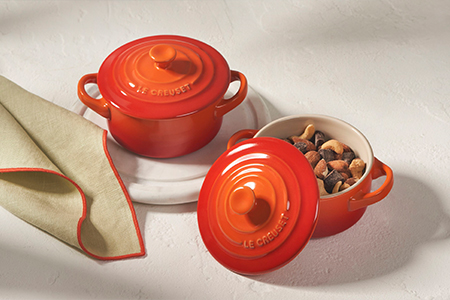
Le Creuset is known and loved for enamelled cast iron but why do certain pieces look different? If you’ve ever asked yourself why some products have a black interior instead of a shiny sand interior, we’ve got the answers.
Before explaining the differences, lets touch on the similarities:
Although visually the colours are completely contrasting, they do have some things in common. For starters, they are both cast iron, but beyond that, they are still both enamelled. The black surface may resemble other cast iron skillets you see, but this one does not need to be seasoned as it has a protective layer of clear enamel over it. In addition, the two products are still highly durable and can be used on any cooktop, including induction.
What’s the Difference?

Matte Surface
With a matte black finish and slightly coarser texture than our sand enamel, many think this surface is actually raw cast iron. However, in fact, our innovative clear enamel coating is applied to the cast iron to create a surface that is much easier to use and clean and requires far less maintenance than traditional cast iron. The clear coat of enamelling means you don't have to worry about seasoning the pan and you can freely use soap to clean it.
Temperatures
These dark interior items are made for higher surface temperature cooking, which makes them ideal for grilling, searing and other dry cooking methods, and results in a nice brown caramelized crust on your food.
Note that higher surface temperature does not equate to high heat, so you should still use medium to medium-high heat settings when cooking with our black satin enameled cast iron cookware.
Patina
The surface of the pan will develop a beneficial patina that enhances cooking performance, and creates a surface that becomes more nonstick over time – just like traditional cast iron. This patina is part of the natural cooking process, and reduces sticking and the need for surface oiling. While easier to maintain than cast iron, you still want to be careful to not scrub off the patina when you clean the pan.
How to Use?
Ready to get grilling? Here is our recipe for indoor grilling success:
- Bring ingredients to room temperature – Room temperature meats, vegetables and tofu, will be easier to sear as they wont need to heat through as much. Try to remove ingredients from the fridge 15-20 minutes before you start cooking.
- Don't forget the seasoning – You don't need to season the cookware but don't skimp on seasoning ingredients before grilling. Opt for spices that emphasize the smokey flavours of an outdoor grill like smoked paprika or chipotle powder.
- Preheat the pan – For even cooking and a perfect sear, your cookware needs to be heated on medium for about 5 minutes.
- Oil the pan – To prevent sticking and help foster a beautiful caramelized crust, lightly oil the cookware before starting. You want to use an oil with a high-smoke point to avoid it burning.
- Practice patience – You know that urge to check on the sear or move things around on the pan? You'll have to fight that for the perfect grill marks or sear. Leave ingredients undisturbed for a few minutes until it naturally releases from the pan. If it still sticks, let it be!
- Rotate 45 degrees – If you are looking to achieve those picture-perfect grill marks, rotate the ingredients 45 degrees before the flip.
- Finish in the oven – Since the pan doesn't provide heat from all around, like in a barbecue, you'll likely have to finish thicker cuts of meat in the oven until cooked to your desired temperature.
- Let it rest – When cooking meats, you'll want to let them rest for 10-15 minutes to avoid releasing all their delicious juices.
- Clean your pan – Follow the steps & video below!
How to Clean?
Le Creuset satin interior products are dishwasher-safe, but we recommend hand washing with these easy-to-follow steps:
- After using the product, allow it to cool slightly. It should be cool to the touch before you start.
- Rinse off any larger stuck on bits in the sink.
- Next fill the product with about half an inch of water and a few drops of mild dish soap.
- Use a non-abrasive sponge or brush, like the Le Creuset Cleaning Brush, to gently scrub the pan to remove any sticky or greasy residue.
- Pour out the dirty water and rinse again until clean.
- Dry the pan thoroughly before putting it away.
- It’s important to note that the satin interior products will likely not look like “new” after cleaning. As mentioned, a patina will build up over time and this is a good thing! So you shouldn’t keep scrubbing the pan as you may remove some of the patina, just like the seasoning on a traditional cast iron pan.

